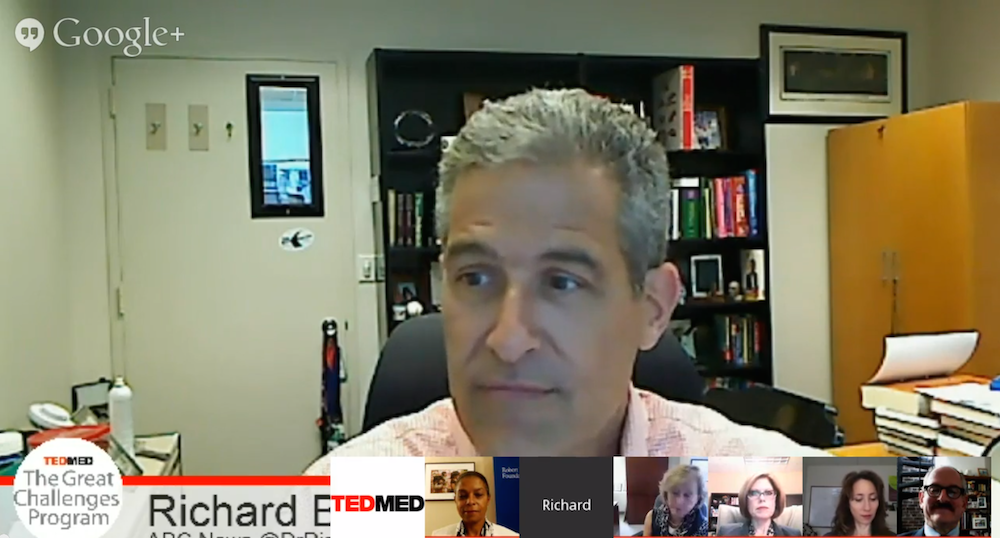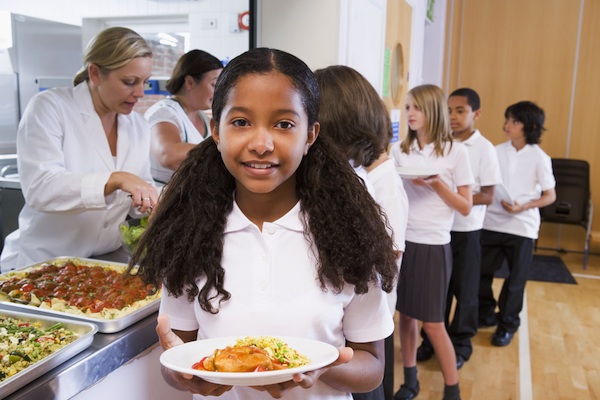Quick Stats About Childhood Obesity
- Nearly 1 in 3 children in America are overweight or obese
- 8.4% of children 2 – 5 years old are obese
- 17% of children 6 – 11 years old are obese
- 20.5% of children 12 – 19 years old are obese
This afternoon, Dr. Richard Besser hosted a conversation on Google+ Hangouts as part of TED-MED to discuss childhood obesity. Dr. Besser is a pediatrician and the Chief Medical Editor at ABC News, and the author of Tell Me the Truth, Doctor, a comprehensive health guide that will both inform and surprise as he deciphers fact from fiction for nearly 70 confusing medical questions.
Dr. Besser assembled a discussion panel for today’s session, including:
- Risa Lavizzo-Mourey, President and CEO of the Robert Wood Johnson Foundation
- Nancy Brown, CEO of the American Heart Association
- Don Schwarz, Health Commissioner and Deputy Mayor for Health and Opportunity, City of Philadelphia
- Elissa Epel, Professor, UCSF School of Medicine
- Lisa Simpson, President and CEO, Academy Health
The group began by talking about stress and the effect it has on health, both in children and adults. Stress is biologically potent and causes us to overeat sweets. Research shows the combination of stress and overeating is “the most dangerous combination,” Elissa says. One of the challenges the group agrees on is taking the research and putting it into practice. Very little is happening so far to create actionable programs that make a difference.
Questions and Answers About Childhood Obesity
For those children who need to lose a substantial amount of weight, how can policies or programs help them reach a healthy weight? Prevention-oriented policies are crucial, but can they realistically help a child lose 50, 70, 100 pounds?
Lisa: Getting children at the right level of care as soon as possible. More support services and resources are needed in the community around them.
Nancy: Emphasize the importance of incremental change. Create an environment where kids can be rewarded by small weight loss at first (5 – 7 pounds), and this will help them progress in the long run so they aren’t discouraged.
Risa: We need more programs that provide supportive environments like the YMCA. We should also be working to get the food industry involved in reducing empty calories in packaged goods, which will help in maintaining weight once it’s lost.
In addressing childhood obesity, is there great enough emphasis on cross-sector approaches, involving public, private, and non-profit organizations?
Don: There’s never enough. The potential for all of us working together is the least-tapped resource. Zoning policy changes in cities and communities can make a big difference. More emphasis should be placed on how government and private sector groups can develop collaborative ways to make a difference (more on that later).
Nancy: Voices for Healthy Kids: collectivity utilize skills of many organizations, public and private, to make a difference. Transportation funding initiatives in some cities have changed to include funding for safe sidewalks, bike lanes, walking paths, and other means for physical activity. This is a great example of cross-sector collaboration.
How early does childhood obesity start?
Elissa: Obesity starts in the womb and with unhealthy pregnancies. Women’s bodies are prepared to put on excess weight during pregnancy, but that excess weight, if too much, can negatively effect the unborn child because obesity is biologically imprinted on babies. It’s a tough problem trying to combat stress and regulate eating and unhealthy environments around women, which only perpetuates obesity.
What other industries should we be partnering with to combat childhood obesity?
Risa: Architects and urban planners are one example. Public health officials make the point that we often have to translate the concepts of a healthy environment to the point where an architect can create buildings that promote healthy activity. This applies to children learning in a healthy environment at school. It’s obvious there’s no single solution; success is achieved by a collaborative effort with everyone aiming for a common goal.
Walking School Buses are the Healthier Way to Carpool
How do we maintain the positive focus on obesity without stigmatizing children who are obese?
Elissa: Kids feel they can’t control their eating and none of them want to be obese. All of the psychology research shows how limited self-control is in certain conditions, including eating, especially when stress and other factors are added to the equation. Stigma is a source of chronic stress, and should be considered toxic to our bodies. It’s a huge problem.
Nancy: Create an environment where children are part of the solution. Due to existing zoning problems, as an example, some families just don’t have easy access to healthy foods.
Lisa: We should be encouraging kids to get engaged in a positive conversation with their families to cook better foods at home.
Risa: An example of getting kids involved: Santa Cruz, CA engaged young people to go out and get local restaurants to add more healthy options to the menus. It made a difference in the community.
35 Quick and Healthy School Night Dinners Your Kids Will Actually Eat
What can local business leaders do to help reduce childhood obesity?
Don: Employers are incredibly important, since they usually have a substantial piece of the environment they control. Work with local Chambers of Commerce to help build and install safe places like playgrounds and parks, and to create safe sidewalks. Small stores and large stores alike that sell food should get involved in the conversation. We need more responsible and healthy choices in their environment. We also need wellness programs from employers that cover dependents. Children learn and make positive changes by having healthy parents encouraging them.
Nancy: Health and well-being of employees has shifted from just an HR effort to something being looked at by top-level executives because of the impact obesity has on the workplace.
What role does the school lunch program have in terms of childhood nutrition, obesity, and education?
Risa: It has a tremendous role because 95% of children are in public and private schools. Children with the highest risk of obesity rely on school breakfast and lunch for a substantial amount of their daily nutrition. Making sure these meals meet health standards is critical. Over the last six months, the acceptance of the new nutrition guidelines is overwhelmingly positive. Children enjoy the meals more and cafeterias aren’t reporting any additional wasted food.
Nancy: Nothing is more important than safeguarding the environment where our children spend a majority of their time each day. It’s unfortunate that it’s become a political issue. Ninety percent of schools have adopted the new nutrition policies around the school lunch program that Risa mentioned.
Don: The school lunch program changes were critical in Philly at reducing childhood obesity. We removed fryers and sugary beverages and added low-fat milk and more healthy food choices. More nutrition education is critical to highlight why things are changing; not as a form of punishment, but to educate kids on how a sugar-rich diet impacts them both now and in the future.
10 Breakfasts with as Much Sugar as a Candy Bar
Progress around the country hasn’t been even, especially across different socio-economic groups. Why is that and how does this effect children?
Elissa: Among people of lower socio-economic status, there’s more stress, which means more propensity to eat junk food as a coping mechanism and fewer opportunities for healthy outlets. It helps to understand that comfort food is a “drug“ — like a cheap form of Prozac. Stress leads to more overeating and stigmatism, which leads to more obesity.
Lisa: From a policy perspective, there’s a lot of variation nationwide. The link between household income and children’s health shows some states like Wisconsin have as much as 3:1 odds of children being obese in low-income areas.
African American and Latino children are exposed to a higher level of unhealthy foods and beverages. What policy changes could be made to counteract this?
Don: All public environments where children participate in activities have the ability for leaders to control the marketing messages children are exposed to. Some understanding and education for how public benefits (like food stamps and WIC) are used could also help. A policy change could allow SNAP benefits to be accepted at farmers markets where families can get fresh, healthy produce.
Risa: Policies in early childhood education settings should be considered that promote healthy foods and physical activity to ensure that more children, especially those in low-income areas, start school at a healthy weight. We just don’t have as much policy data that we’d like at this time and we’re continuing to evaluate what actually works. We’re looking at many local experiments like taxes on overly sugary beverages (the “soda tax“) and what effect they have on consumption of empty calories.
Nancy: The American Heart Association has found in early studies that a 10% increase on the price of sugary beverages (via “soda tax”) leads to a decrease in consumption of 8-10% in children. While this is encouraging, we’re also looking at obtaining additional data.
ALSO READ:
Wealth is Health: Poorest States Trend Highest for Obesity, Cancer, Poor Dental Health




